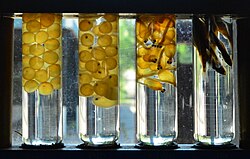Salmonidae
The Salmonidae is a family of ray-finned fish. They are the only living family in the order Salmoniformes. It includes salmon, trout, chars, graylings, and the subfamily known as the freshwater whitefish.
| Salmonidae | |
|---|---|

| |
| Coho salmon (Oncorhynchus kisutch) | |
| Scientific classification | |
| Unrecognized taxon (fix): | Salmoniformes |
| Family: | Salmonidae G. Cuvier, 1816 |
| Type genus | |
| Salmo | |
The Atlantic salmon and trout in the genus Salmo give the family and order their names.
Salmonids look rather primitive for teleost fish. Their pelvic fins are placed far back, with an adipose fin towards the rear of the back. They are slender fish, with rounded scales and forked tails. Their mouths contain a single row of sharp teeth.[1] Although the smallest species is just 13 cm (5.1 in) long as an adult, most are much larger, with the largest reaching 2 m (6.6 ft).[2]
All salmonids spawn in fresh water. In many cases the fish spend most of their lives at sea, returning to the rivers only to reproduce. This a migratory lifecycle. They are predators, feeding on small crustaceans, aquatic insects, and smaller fish.[1]
Taxonomy
Order Salmoniformes
- Family: Salmonidae
- Subfamily: Coregoninae
- Coregonus - whitefishes (78 species)
- Prosopium - round whitefishes (6 species)
- Stenodus - beloribitsa and nelma (2 species)
- †Beckius (1 species, Oligocene)
- †Parastenodus (1 species, Eocene)
- Subfamily: Thymallinae
- Thymallus - graylings (14 species)
- Subfamily: Salmoninae
- †Eosalmo (1 species, Eocene)
- †Paleolox (1 species, Late Miocene)
- Tribe: Salmonini
- Salmo - Atlantic salmon and trout (47 species)
- Salvelinus - Char and trout (e.g. brook trout, lake trout) (51 species)
- Salvethymus - Long-finned char (1 species)
- Tribe: Oncorhynchini
- Brachymystax - lenoks (4 species)
- Hucho - taimens (4 species)
- Oncorhynchus - Pacific salmon and trout (12 species)
- Parahucho - Sakhalin taimen (1 species)
- Subfamily: Coregoninae
Extinct genera
Salmonidae
- Eosalmo (belongs to this family)
Orthogonikleithridae
- Leptolepides (belongs to the family Orthogonikleithridae)
- Orthogonikleithrus (belongs to the family Orthogonikleithridae)
Gallery
Rainbow trout (Oncorhynchus mykiss)
Arctic grayling (Thymallus arcticus)
Atlantic salmon (Salmo salar)
Salmonidae Media
Oncorhynchus mykiss maturing from eggs.
References
- ↑ 1.0 1.1 McDowell, Robert M. 1998 (1998). Paxton J.R. & Eschmeyer W.N. (ed.). Encyclopedia of Fishes. San Diego: Academic Press. pp. 114–116. ISBN 0-12-547665-5.
- ↑ Cite error: Invalid
<ref>tag; no text was provided for refs namedFB.
Other websites
![]() Media related to Salmonidae at Wikimedia Commons
Media related to Salmonidae at Wikimedia Commons











